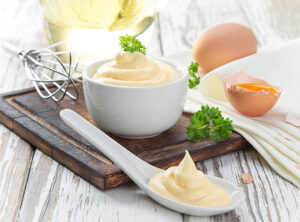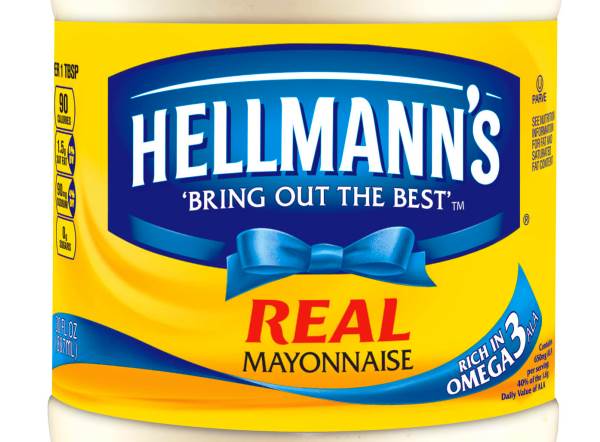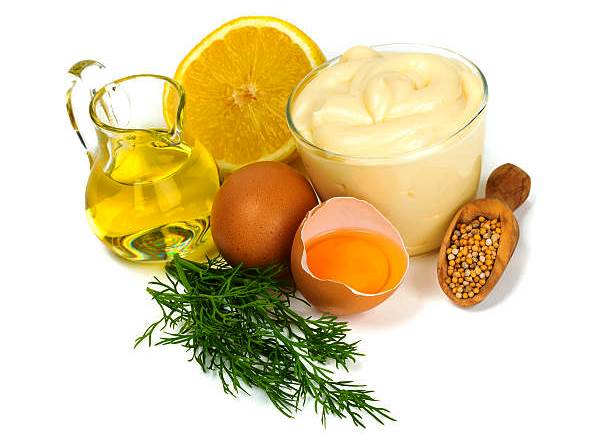A few of years ago, NPR aired a segment called “Happy Birthday, Dear Mayo — We Hold You Dear” in order to mark the 250th ‘birthday’ of that useful and ever-present condiment, mayonnaise.

Mere condiment? Did I say condiment? Isn’t it so much more than that? It is the stuff of culinary creativeness. I don’t even like the stuff that much and even I admire its usefulness. It is the basis for sauces, the glue for salads, the moistener for many a sandwich – even a home remedy for aching joints.
That last one is according to Wikipedia and while I’ve not heard that myself (and I’m well aware that Wikipedia isn’t 100% to be counted on) why would someone make up something that weird and that random? We shall take it as given until someone makes a case otherwise.
There is no existing culinary celebration of mayo on any list I’ve found. So I am, partly because I can and partly at the request of a friend whose hubby puts mayo on everything, declaring that May 21st is, from this day hence, to be known as Fabulous Foodie Mayo Day. (insert sound of cheering crowds here)
And so that we all know what we’re talking about by then, I’ve dug around and herein lay bare the truth, the assumptions and the mechanics of mayonnaise, our fabulous food friend.
So mayonnaise. Where did it come from?
Like many “food origin” questions, the real answer is that no one really knows. But the most commonly accepted and reasonable sounding explanation is that it was created to celebrate the capture of Mahon by the Duke of Richelieu in 1756. That would be Louis François Armand du Plessis, duc de Richelieu, by the way – not to be confused with his Grand-uncle Cardinal-Duc de Richelieu, linchpin of French history, chief moustache twirler in the Three Musketeers and – as I have pointed out – the creator of cutlery.

Now, if you ask me, it seems an odd way to celebrate a military victory but the Duke was an odd duck (often insisting that his invited dinner guests dine in the nude) and the truth is that it was all probably due to supply shortages. The cook, prepping the victory feast discovers that “Sacrebleu! We have run out of cream! Mon Dieu, I am ruined!” Trying not to panic, he knows that must decide quickly how to salvage the situation or his reputation will be ruined. Suddenly – inspiration! A substitution can be made. He cries out, “Marcel! The olive oil! Tout suite!” It may not have gone exactly like that but something to that effect.
Other French cities like Bayonne and Les Mayons also claim to have been the birthplace of mayo – Bayonne actually going so far as to claim that it was originally called bayonnaise before a typo changed history. But you know, until they come up with a story as good as a hyperventilating French cook, his assistant Marcel and a nude dinner party at the Duke’s – I’m sticking with the story above.
The Emulsion Rises (and gains ground)
With the origins clouded in mystery, I am happy to report that the popularity of mayo is easier to track. As far as the United States in concerned, it all took off in 1905 when Nina Hellman made a dressing that her husband Richard used on the sandwiches and salads he served in his New York City delicatessen. It was wildly popular and he started selling the dressing (in wooden ‘butter boats’) with great success.
Actually, he sold two versions – and to differentiate between the two, he put a blue ribbon around one. In just a couple of years, the demand for the blue ribbon version was so outpacing the demand for the other that Hellmann designed a “Blue Ribbon” label and started using larger glass jars. In 1912, with the Blue Ribbon selling better than ever, he bought some trucks, started a distribution business and built a manufacturing plant. Over on the West Coast, Best Foods was doing the same and in 1932, the two operations merged. Now – years later – account for about 45% of all bottled mayonnaise sold in the United States.

Mayo – The World’s Condiment
Mayo is hugely popular all over the world as a key element of sandwich and salads but different regions have their own mayo trends and variations as well.
- In Europe – particularly in Northern Europe, mayo is a popular condiment for French fries or chips. Now, I personally can’t abide the idea but so many people do it that there must be something to it. Try it. You may like it.
- Japanese mayo is – to American or European palates – a bit thinner but no less tasty. And the taste is a tad unexpected as well as they often use apple cider vinegar or rice vinegar as their acid rather than lemon or distilled vinegar.
- In Russia, they use sunflower seed oil and according to market research, it is also in Russia where mayo outsells ketchup.
Mayo Mechanics
Mayonnaise falls into that category of foods that I classify as misunderstood. Why? Because if you suggest to someone that they might want to try making their own mayo, they will look at you like you’ve grown a second head. “Get thee behind me, lunatic!” their expression will say. Their gasp will express the horror at the idea of taking on such a difficult task. But that’s the thing. Mayonnaise is just an emulsion of oil and egg yolks, with a little acid and salt added to perk it up. It’s not difficult. Brain surgery is difficult. Whisking is not. And whisking is all that’s involved. Don’t believe me? Take a look at this basic mayo recipe.
Ingredients:
– 1 cup oil
– 1 egg yolk*
– 2 tablespoons of lemon juice
– Salt and pepperDirections: Beat egg or egg yolks with a whisk (hand or electric, depending on your stamina and attention span) until slightly thickened. Add 1 teaspoon oil at a time whisking well after each, until 1/3 cup has been added. Add a few drops lemon juice. Whisk. If oil was added at the right rate and whisking sufficient, the mixture should be quite thick and smooth. If it isn’t, the oil was added too quickly or you need to whisk more after each addition. Continue to alternate adding the oil and acid until it is used up. Add seasonings to taste. Store covered in the refrigerator. Yield: 1 Servings.

Now honestly, is that worth wailing and gnashing of teeth? No. It’s half a grocery bag of items, a bowl, a whisk, a spoon (or dropper), a little elbow grease and 5 minutes. And you know what? It might help fight those flabby underarms as well.
Still not convinced? Think the pros and celeb chefs must do it differently? Ok, let’s see. Here is the basic mayo recipe from the French Fare episode of Paula’s Home Cooking
Ingredients:
– 2 egg yolks*
– 2 tablespoons mustard
– Dash salt and pepper
– Squirt of lemon juice
– 1 to 1 1/2 cups oilDirections: Put ingredients in blender, and blend slowly, adding oil until you have desired consistency. Yield: 1.5 cups
Gosh, how straight-forward is that. Feeling a bit better about mayo manufacturing now? Good. So let’s push the envelope out a bit more.
Variations on the Mayonnaise Theme
Guess what? You don’t have to stick to plain, basic mayo. You can spice it up, give it an edge, sweeten it – customize your condiment and make your party platters something special. People will notice.
A quick search of the internet offers up a startling range of mayo variations but here is a quick list of ways to jazz up your mayo for a special occasion or to bring a little extra something to a meal. You can start with your own basic recipe as above or even just use store bought mayo. Just ’cause it’s not hard doesn’t mean you should spurn the commercial stuff every single time.
- Aioli: Mix 1 cup mayonnaise with 4 cloves garlic ground or processed into paste.
- Chantilly Mayonnaise: Start with approx. 1 cup mayonnaise, then fold in 1/2 cup heavy cream that has been whipped into soft peaks.
- Curry Mayonnaise: Mix approx. 1 cup mayonnaise with 1 to 2 teaspoons curry powder. This is very much to taste – as are they all but curry preferences are – I find – an especially personal thing.
- Dill Mayonnaise: Mix 1 cup mayonnaise, 3 Tbsp. minced fresh dill and 1 tsp. lemon juice thoroughly. Stare wide eyed in amazement at the ease of it all.
- Fruit Mayonnaise: Start with approx. 1 cup mayonnaise. Then mix in 3 tablespoons each orange juice and superfine sugar, 1 teaspoon finely grated orange rind, and a pinch nutmeg.
Want an extra punch? Mix in 1 tablespoon Grand Marnier or other fruit liqueur. - Harissa Mayonnaise: Mix 1 cup mayonnaise and 1 Tbsp. harissa thoroughly. Tah-da! Done.
- Mustard Mayonnaise: Mix approx. 1 cup mayonnaise with 4 teaspoons Dijon mustard.
- Remoulade Dressing: Mix approx. 1 cup mayonnaise with 1 tablespoon each minced capers and gherkins, 2 teaspoons each anchovy paste and Dijon mustard, and 1 teaspoon each minced parsley and fresh chervil.
- Russian Mayonnaise: First, have a minion elected Prime Minister – whoops! Sorry. Never mind. Just mix approx. 1 cup mayonnaise with 1/4 cup black or red caviar, 1/2 cup sour cream, and 1 tablespoon minced fresh dill.
- Sauce Nicoise: Mix 2 tablespoons tomato puree with 2 minced pimientos and 1/2 crushed clove garlic; press through a fine sieve and blend into approx. 1 cup mayonnaise
So, grab those eggs, find that whisk – make yourself some mayonnaise or buy some in time to celebrate Fabulous Foodie Mayo Day in your own way. Me? I’m gonna go make some Russian dressing.
* RAW EGG WARNING: Now listen – Food Network (who put out umpteen cooking shows a year), every cookbook author and publisher in the past two decades, the Food & Drug Administration and Fabulous Foodie all suggest using caution when cooking with and consuming raw and barely-cooked eggs. This is due to the slight risk of Salmonella or other food-borne illness. To reduce the risk, it is recommended that you use only fresh, properly refrigerated, clean, grade A or AA eggs with intact shells, and avoid contact between the yolks or whites and the shell.

2 thoughts on “The Myths and Making of Mayonnaise”